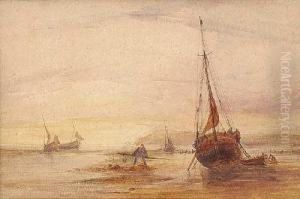Otto Magnus Von Stackelberg Paintings
Otto Magnus von Stackelberg was a Baltic German nobleman, archaeologist, painter, and art historian, born on May 25, 1786, in Reval (today Tallinn), in the Russian Empire (now Estonia). He belonged to the Baltic German noble Stackelberg family, which played a significant role in the history of the Baltic region. Otto's upbringing in an aristocratic family afforded him the education and means to pursue his interests in the arts and archaeology, which would later define his professional career.
After completing his studies in Germany, Stackelberg embarked on a grand tour, a rite of passage for many young European aristocrats of the time, which took him to Italy and Greece. These travels deeply influenced him, and he decided to dedicate his life to the study of ancient art and archaeology. He settled in Rome, which was a center for artists and scholars during the early 19th century, and became part of its vibrant expatriate community. His residence in Italy was punctuated by extensive travels to Greece, where he conducted archaeological research and participated in excavations, making significant contributions to the field of classical archaeology.
Stackelberg is best remembered for his detailed studies and drawings of Greek antiquities, as well as his pioneering work in the field of archaeology. One of his most significant contributions was his involvement in the excavation of the Temple of Aphaia on the Greek island of Aegina and his subsequent publication, 'Der Apollotempel zu Bassae in Arcadien', which presented his findings and analysis. His works provided valuable insights into Greek architecture and were instrumental in the study of classical antiquities by later scholars.
In addition to his archaeological pursuits, Stackelberg was also an accomplished artist. He produced numerous sketches and paintings of landscapes, ancient ruins, and scenes from his travels, capturing the beauty and historical significance of the Mediterranean region. His artistic works were not only valuable for their aesthetic appeal but also for their historical accuracy and contribution to the documentation of archaeological sites.
Otto Magnus von Stackelberg died on October 27, 1837, in Naples, Italy, but his legacy lived on through his contributions to the study of ancient Greek art and architecture. His works continue to be referenced by scholars and remain an important part of the history of classical archaeology and art history.
